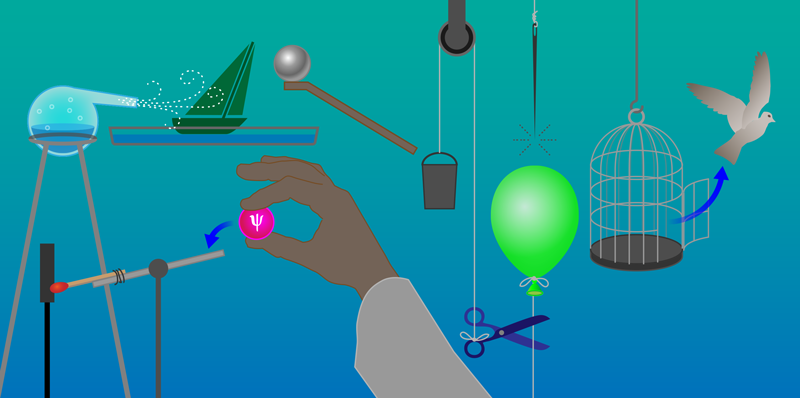Causality in the Quantum World
Mathematical models for deducing cause-effect relationships from statistical data have been successful in diverse areas of science (see Ref. [1] and references therein). Such models can be applied, for instance, to establish causal relationships between smoking and cancer or to analyze risks in construction projects. Can similar models be extended to the microscopic world governed by the laws of quantum mechanics? Answering this question could lead to advances in quantum information and to a better understanding of the foundations of quantum mechanics. Developing quantum extensions of causal models, however, has proven challenging because of the peculiar features of quantum mechanics. For instance, if two or more quantum systems are entangled, it is hard to deduce whether statistical correlations between them imply a cause-effect relationship. John-Mark Allen at the University of Oxford, UK, and colleagues have now proposed a quantum causal model based on a generalization of an old principle known as Reichenbach’s common cause principle [2].
Historically, statisticians thought that all information about a system could be represented in terms of statistical correlations among its variables. Nowadays, however, it is recognized that the concept of causal information goes beyond that of correlation. For example, compare the statistical statement “the number of cars is correlated with the amount of air pollution” and the causal statement “cars cause air pollution.” The statistical statement goes both ways: Knowing there are more cars, I can infer that the air is more polluted. Similarly, knowing the air is more polluted, I can infer that there are more cars. The causal statement tells us more; namely, if we change the number of cars, we can affect air pollution, but not vice versa—polluting the air by other means (say by building factories) will not affect the number of cars. Causal information is different from correlations because it tells us how the system changes under interventions.
In classical causal models, statistical and causal information are related by the Reichenbach’s principle. This principle states that two correlated variables must have a common cause: either one is a cause of the other or there is a third variable that is a common cause of both. In the latter case, the correlation will disappear if probabilities are conditioned to the common cause. For example, the incidence of tsunamis in Chile is statistically correlated with that of tsunamis in Japan. In statistical terms, the combined probability for two tsunamis is greater than the product of the separate probabilities for tsunamis in Chile and Japan. But neither event is a cause of the other. If we condition the tsunamis’ probabilities on the knowledge that an earthquake has occurred in the Pacific basin, then we should find that the events are independent: the combined (conditional) probability of the two is equal to the product of the separate (conditional) probabilities. In other words, the correlation disappears. Given our knowledge of an earthquake, the news that a tsunami occurred in Chile no longer gives us any extra information about the probability that a tsunami occurred in Japan. Reichenbach’s conditional independence suggests that the earthquake might be the common cause of the tsunamis in the two regions.
Besides providing clues about causal relationships, conditional independence relations tell us how to update the probability of an event based on new information related to the event—a procedure called Bayesian inference. The two types of inference (Bayesian and causal), connected by Reichenbach’s principle, are the heart of causal models. A quantum extension of such models should provide a framework for both.
In the case of two entangled particles, Reichenbach’s principle would suggest that the correlations between the particles could be explained by a common cause. However, we also know that quantum statistics can violate Bell’s inequalities, which means that variables serving as common causes that could make the correlation disappear cannot exist. A quantum causal model should redefine the connection between causal statements and statistical observations by accounting for this phenomenon (see Fig. 1). It should also tell us how to derive conditional independence relations, which in turn allow us to perform Bayesian updating of probabilities. Finding a model that meets both of these requirements has been challenging.
Most early attempts at quantum causal models proceeded by defining causal structures for quantum systems and then finding which conditional independence relationships remained intact [3]. However, these models could not perform Bayesian inference because conditional independence was no longer a prerequisite for identifying a common cause. Matthew Leifer and Robert Spekkens [4] attempted to incorporate Bayesian inference in a quantum framework using “conditional quantum states” in place of conditional probabilities, but this creative approach was found to be applicable only in restricted cases. Fabio Costa and Sally Shrapnel [5] set aside the problem of conditional independences to focus on causal interventions. For example, instead of considering the conditional independence of tsunamis in Chile and Japan, their approach would consider whether creating or preventing earthquakes (an intervention) would trigger or suppress the tsunami events through physical processes. This model allowed causal relationships to be defined, but it lacked the conditional independences with which to perform Bayesian inference.
Building on the work of Costa and Shrapnel, Allen and his colleagues set out to restore conditional independence as a prerequisite for common causes. To do so, they took advantage of an old physical argument that derives Reichenbach’s principle by assuming that statistical data are the result of a deterministic model. For instance, rolling dice in a casino might appear random, but it could be explained, in principle, by a croupier whose skills allow him to determine the outcome of each throw. While it is debatable whether quantum systems are compatible with this type of determinism, they are compatible with another type of determinism called unitary evolution. A process is called unitary if it conserves quantum information. Compatibility with unitarity is a central tenet of quantum mechanics.
Allen et al. realized that by replacing “deterministic” with “unitary” in Reichenbach’s principle they could obtain a new version of quantum causal models. In particular, their quantum version of the Reichenbach principle allowed them to relate conditional independence to quantum causal relationships like those described in Costa and Shrapnel’s model. What’s more, these conditional independence relations could then be used to perform Bayesian inference. Allen et al.’s result combines both causal interventions and Bayesian inference into a single model, succeeding where others had failed.
Several research groups, including mine, are still exploring a range of alternative quantum causal theories. But the new model by Allen and colleagues is the first to meet all requirements of a quantum causal model, providing a uniquely quantum definition of causality. Thanks to results like this, we may find that quantum mechanics has a causal interpretation, just like classical mechanics. We might also reveal the mechanisms that are behind observed correlations and pinpoint the interventions that manipulate such mechanisms. In a few words, this would amount to bringing back some cause-effect “intuition” into the spooky and bizarre world of quantum mechanics.
This research is published in Physical Review X.
References
- J. Pearl, Causality: Models, Reasoning and Inference (Cambridge University Press, Cambridge, 2009)[Amazon][WorldCat].
- J.-M. A. Allen, J. Barrett, D. C. Horsman, C. M. Lee, and R. W. Spekkens, “Quantum Common Causes and Quantum Causal Models,” Phys. Rev. X 7, 031021 (2017).
- K. Laskey, “Quantum Causal Networks,” arXiv:0710.1200; R. R. Tucci, “Quantum Bayesian Nets,” Int. J. Mod. Phys. B 9, 295 (1995); T. Fritz, “Beyond Bell’s Theorem II: Scenarios with Arbitrary Causal Structure,” Commun. Math. Phys. 341, 391 (2015); J. Henson, R. Lal, and M. F. Pusey, “Theory-Independent Limits on Correlations from Generalized Bayesian Networks,” New J. Phys. 16, 113043 (2014); J. Pienaar and Č. Brukner, “A Graph Separation Theorem for Quantum Causal Models,” New J. Phys. 17, 073020 (2015).
- M. S. Leifer and R. W. Spekkens, “Towards a Formulation of Quantum Theory as a Causally Neutral Theory of Bayesian Inference,” Phys. Rev. A 88, 052130 (2013).
- F. Costa and S. Shrapnel, “Quantum Causal Modelling,” New J. Phys. 18, 063032 (2016).





